Article:
The Apocrypha and the Bible Canon
A historical and theological overview
The Bible Library™

What does “Apocrypha” mean?
"writings or statements of dubious authenticity"
The word apocrypha comes from the Greek and means “hidden” or “secret.” In Christian tradition, it has come to denote writings of uncertain or questionable authenticity (Apocrypha: "writings or statements of dubious authenticity". Merriam-Webster). The apocryphal books were written mainly during the period between the Old and New Testaments, and they circulated in the Greek translation of the Old Testament, the Septuagint, as well as in the Latin Vulgate.
Never part of the Hebrew Bible
The Apocryphal books have never been recognized as part of the Jewish Bible (Tanakh). Jewish rabbis considered them historically interesting, but not inspired by God. This is also confirmed in the New Testament: neither Jesus nor the apostles ever quote from the
Apocrypha as holy Scripture. On the contrary, Jesus confirms the Jewish canon when he says:
“That upon you may come all the righteous blood shed on earth, from the blood of Abel … to the blood of Zechariah the son of Barachiah” (Matthew 23:35).
Here Jesus delineates the entire Hebrew Scriptures—from Genesis (Abel) to Second Chronicles (Zechariah)—the first and last books of the Jewish canon. The Apocrypha falls outside this delineation.
Paul emphasizes in Romans 3:1–2 that the Jews had a special trust: “..unto them were committed the oracles of God”. It is therefore the Jewish canon that Jesus and the apostles recognize as God’s holy Scripture. Since the Jews never included the Apocrypha in their canon, these writings cannot be counted as part of the inspired Oracles that God entrusted to Israel. Yes, God entrusted the Scriptures to the Jews, not to the Catholic Church.
The Catholic Church's decision
During the Reformation, the Protestant churches rejected the Apocrypha as canonical Scripture. In response, the Roman Catholic Church, at the Council of Trent (1546), declared the Apocrypha to be as holy and inspired as the books of the Old and New Testaments. The Council issued a stark warning:
“If anyone does not acknowledge these books in their entirety as holy and canonical…let him be anathema (cursed and excommunicated).”
This was thus a direct reaction to the Reformation's focus on the Hebrew canon and the authority of Scripture.
The view of King James I
King James I of England, who was behind the 1611 Bible translation (KJV), was clear in his disapproval:
“As for the Apocryphal books, I omit them because I am not a Papist …”
(Basilikon Doron, 1599).
His stance reflects the classic Protestant position: The Apocrypha can be read for moral edification, but they are not the inspired Word of God and cannot be used to establish doctrine.
The Apocrypha in the 1611 King James Bible
When the KJV was printed in 1611, the Apocrypha were included – but in a separate section between the Old and New Testaments, clearly marked with the heading Apocrypha. The word Apocrypha appeared twice on each page, to show that these books were not canonical.
They were considered to be read “for examples of life and manners” but not to establish any doctrine. This was also in line with the legal obligation that existed in England at the time: according to church law and printing privileges, it was forbidden to publish a Bible completely without the Apocrypha. Anyone who did so risked a fine.
It was not until the 19th century, through societies such as the British and Foreign Bible Society, that English Bibles began to be printed completely without the Apocrypha.
Which books are considered the Apocrypha?
The 1611 KJV contained the following 14 books:
Första Esra (1 Esdras)
Andra Esra (2 Esdras)
Tobit (Tobit)
Judith (Judeth)
Tillägg till Ester (The Rest of Esther)
Salomos Vishet (Wisdome)
Jesus Syraks Vishet (Ecclesiasticus)
Baruk (Baruch)
Sången av de tre männen i ugnen (The Song of the Three Children)
Historien om Susanna (The Story of Susanna)
Bel och draken (Bel and the Dragon)
Manasses’ bön (The Prayer of Manasses)
Första Mackabeerboken (1 Maccabees)
Andra Mackabeerboken (2 Maccabees)
Summary
The Apocryphal books have historically had a place in Bible editions, but they are not part of the Holy Scriptures. They:
Have never been included in the Jewish canon (Tanakh).
Not recognized by Jesus or the apostles.
Have been used by the Catholic Church to support certain doctrines, but were rejected by the Reformers.
Were clearly marked as Apocrypha in the 1611 King James Bible, separated from the Old and New Testaments.